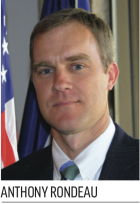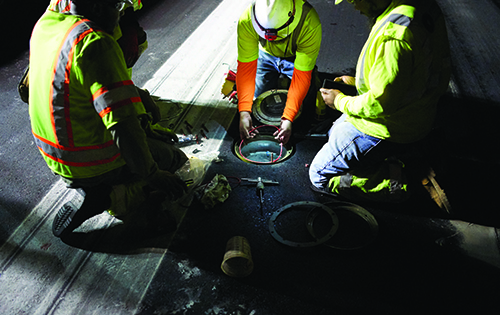Norfolk Int’l Completes Nail-Biter Runway Rehab

The first phase of a multi-part runway rehabilitation project was completed at Norfolk International Airport (ORF) last fall. The $15 million project was closely monitored by many, including commercial and cargo airlines that depend on the Virginia airport every day.
 It was early 2015 when airport personnel began noticing that the lights on ORF’s sole commercial runway were out of grade tolerance. For the next year and a half, efforts were made to raise the lights by filling around and underneath the cans. Maintenance crews monitored and adjusted the cans until more extensive work could be done, explains Anthony Rondeau, deputy executive director of Engineering and Facilities at the Norfolk Airport Authority.
It was early 2015 when airport personnel began noticing that the lights on ORF’s sole commercial runway were out of grade tolerance. For the next year and a half, efforts were made to raise the lights by filling around and underneath the cans. Maintenance crews monitored and adjusted the cans until more extensive work could be done, explains Anthony Rondeau, deputy executive director of Engineering and Facilities at the Norfolk Airport Authority.
“At first it seemed like a few isolated issues. But then it gradually became a challenge that impacted all the cans in the center 6,000-foot asphalt section of the runway,” Rondeau recalls. “Our maintenance efforts were successful for a time, but certainly nothing permanent.”
|
facts&figures Project: Runway Rehab & Centerline Replacement Location: Norfolk (VA) Int’l Airport Owner: Norfolk Airport Authority Project Cost: $15 million Construction: Aug. 7-Oct. 28, 2018 Prime Contractor: Virginia Paving Co.-Hampton Roads Electrical Contractor: Atlantic Electric, LLC Prime Design Contractor: Kimley-Horn Design Subcontractor: Connico Inc. Quick-set Concrete: Western Materials |
That’s when the airport began working on a long-term fix.
In early August 2018, it closed Runway 5-23, and 178 workers and 76 pieces of equipment got to work. Each night, crews performed carefully choreographed work sequences for less than four hours, and then cleaned away the equipment and debris so the 9,000-foot runway could open at 5 a.m. the next morning.
That routine continued seven days a week until late October, with only five days impacted by rain. “Even then, contractors were able to be productive with saw cutting, coring and other similar efforts,” Rondeau reports.
Bracing for the Big Challenge
Preparations for the three months of active construction began in fall 2016, when the airport authority hired Kimley-Horn to perform a thorough runway evaluation. In addition to the settling can lights, roughness was also a major concern, notes Robert Jones, project manager at Kimley-Horn. The center 6,000-foot section of the runway contained original asphalt from the 1940s, and the two 1,500-foot-long concrete end sections were more than 40 years old. While the runway had been maintained, aircraft tires had worn the grooving off of many areas and time had generally taken its toll.
 The team scheduled Phase 1 of the runway rehabilitation for 2018, with at least two or three more phases to follow. The second construction project is slated for 2020. “We’re looking to do the two runway ends in separate years, and then the center section the following,” explains Jones. “We just have to keep this runway open and operational around some major rehabilitation work.”
The team scheduled Phase 1 of the runway rehabilitation for 2018, with at least two or three more phases to follow. The second construction project is slated for 2020. “We’re looking to do the two runway ends in separate years, and then the center section the following,” explains Jones. “We just have to keep this runway open and operational around some major rehabilitation work.”
Rondeau notes that project team relied heavily on Kimley-Horn’s guidance to help make airport officials comfortable with the design and associated amount of work required for Phase 1.
“They were able to reference prior projects where they had addressed these exact issues and knew what construction techniques had to be used,” he says. “The initial primary objective was to deal with the light cans for the center line, so that’s what we did.”
About one month before construction began, Virginia Paving Company-Hampton Roads came on board as the primary contractor, and Atlantic Electric was hired as the primary electrical contractor.
“We had to get it together really quickly,” says Brian Nettles, division manager of Airfields & Special Projects for Atlantic Electric. “The timeline was very aggressive, but so was the project itself. I needed several top crews for this job.”
Mark Range, an assistant plant manager with Virginia Paving who was active at the project site, notes that airport personnel became more comfortable with the tight work schedule after seeing the runway open on time each morning. “When we started the job and tasks began to go like they were supposed to each night, we gained their trust,” says Range. “They grew confident in what we were doing quite quickly.”
On a related note, Rondeau counsels other airports to “go with their gut” when designing and executing such projects. “Pick a team and a process that you’re comfortable with,” he advises, noting that the project owner must be completely on board, since that’s who will be held accountable if anything goes wrong. “One of my biggest takeaways from this project was the need to be comfortable at all times with all actions taking place on your runway, regardless of size.”
 Team ORF
Team ORF
Steve Sterling, deputy executive director at the Norfolk Airport Authority, describes the key portion of ORF’s recent project as open-heart surgery on the runway. The center was cut open, repaired and put back together strong enough to hold aircraft within five hours. Pulling it off required a team of expert contractors and an acute awareness of safety, he emphasizes.
The crews that worked side-by-side on the project thoroughly impressed Lonnie Minson, operations manager for Virginia Paving Company-Hampton Roads. “These weren’t problem people, they were solution people,” says Minson. “It took many, many entities to make it come together and put that runway back in service by 5:00 each morning.”
The prime contractor and subcontractor had extensive aviation fieldwork experience and were very knowledgeable—which is not always the case, notes Sri Kumar, a project engineer at Connico. Nevertheless, everyone was still willing to learn, take suggestions and ask questions, he adds.
 “The thing I’m most proud of is the way the team handled everything,” says Kumar. “The engineers responded quickly. The contractor and his subs were very open to communications. Everyone really had the interest of the project in mind.”
“The thing I’m most proud of is the way the team handled everything,” says Kumar. “The engineers responded quickly. The contractor and his subs were very open to communications. Everyone really had the interest of the project in mind.”
Kumar’s sentiments are echoed throughout the extensive project roster.
Minson says the No. 1 lesson learned was the importance of teamwork and communication. “If you don’t have a good team, you’re not going to succeed on a project like this,” he says. “We hit no glitches, which is rare. But all of our subcontractors understood that if there was an issue, it wasn’t just their problem, it was everybody’s; and whatever we had to do, we would to fix it.”
The Norfolk Airport Authority noticed, and valued, the tangible team spirit.
“Everyone knew they had to achieve a significant amount of work each night and that squabbling over little details wasn’t going to get anybody anywhere,” Rondeau observes. “It was a very cooperative group, which made the project work.”
 Nettles acknowledges that he initially worried about all the things that could potentially go wrong, because there was so little time each night for the crews to adjust. “They could handle it, but some of them had never been under that extreme level of pressure,” he explains. “Our guys did a wonderful job.”
Nettles acknowledges that he initially worried about all the things that could potentially go wrong, because there was so little time each night for the crews to adjust. “They could handle it, but some of them had never been under that extreme level of pressure,” he explains. “Our guys did a wonderful job.”
Single-Runway Scheduling
The airport, Kimley-Horn and Connico worked together to devise an intricate timetable for the project. Coordinating with ORF’s airline partners, they developed a detailed 12-week overnight runway closure schedule.
Rondeau says scheduling with the airlines was simple, because they were cooperative participants and notified the airport about their published flight schedules far in advance. They understood the limited flexibility ORF had with one commercial runway and wanted the work to be completed for their benefit, he explains.
“Just to accommodate the five-hour closure, we set the construction schedule 10 months in advance,” says Jones. “For Phase 2, we’re looking at 18 months to coordinate with the airlines.”

The list of nighttime pavement work was long: concrete repair, concrete replacement, profile milling, survey work, correcting center grades, striping, sealcoating, crack sealing. And at the same time, Atlantic Electric was performing work on the lights.
To get it all done, coordination had to start months in advance.
“We established everything on paper beforehand,” says Kumar. “Then, we got to the site early every night, staged the equipment, made sure it worked, verified that everybody we needed was there, reviewed the plan and also kept an eye on the weather.”
The go/no go call was made each night by 11:30 p.m. so security checks could be performed before work began. In particular, centerline demolition required specific weather conditions. “It was a big decision every night,” recalls Range. “Luckily, we never really got caught. Sometimes there was a chance we didn’t want to take, and it rained later and we thanked ourselves for pushing ahead.”
Minson notes that the work plan included many layers of redundancy, including backup crews, equipment and materials. Contingencies were in place for everyone and everything, every single night, he emphasizes.
The goal wasn’t simply to complete the prescribed work each night; crews and equipment also had to get off the runway before aircraft would be waiting to depart. “We were never, ever late—not one single minute,” reports Minson.
And every morning, the runway needed to be completely clear.
“We couldn’t even leave one stone,” says Range. It took 20 minutes to set up each night, and another 30 to 45 minutes to clean up the following morning. That left no more than 3½ hours of work time in between.

Practice Makes Perfect
Extensive testing and preparations before the project began helped provide Sterling and other airport representatives peace of mind. Crews even used a surplus piece of pavement to rehearse techniques and model the results.
Workers used the Runway Pavement Profiler (built and operated by Pavement Technical Solutions Inc.) to measure the runway profile and determine Boeing Bump Index levels of roughness over the length of the runway. This allowed the team to develop plans for roughness mitigation. Profile grinding and pavement removal/replacement to established new grades provided significant smoothness improvements, notes Jones.
Quick-set concrete by Western Materials was the project’s saving grace—but also a substantial challenge, says Minson. “You’d have 10 minutes and it was set, and then you couldn’t work it,” he explains. The concrete set to 4,500 psi in just 60 minutes.
“There were a lot of nervous people,” adds Jones. “So before we went out, we field-tested all of this. We did test anchor installations, both helical pile and the rapid-set concrete, then we tested light installations.”
All the preparations apparently paid off.
“When the construction was done, we ran the Profiler over the runway and it came in at an acceptable level without any further work,” Sterling reports proudly.
Needless to say, the airlines were pleased to see the project end successfully; and so was the airport.
“This is the first time in a very, very long time we’ve been able to sleep at night knowing all of the centerline lights are within tolerance,” concludes Rondeau. “It’s a big relief to our staff not having to keep up that level of constant maintenance.”
FREE Whitepaper
Fairbanks International Airport Baggage Transport Conveyor Enhanced With Mod Drive™ System
Airports face a host of unique industry challenges, such as meeting efficiency regulations and seeking out the best maintenance practices to reduce costs and keep operations flowing. In today’s current economic climate, any potential cost savings can go a long way.
In 2019, Alaska’s Fairbanks International Airport (FAI) sought to modernize its equipment and operations. They were dissatisfied with the performance of the gearmotors on their baggage transport conveyors and began searching for new suppliers. Regal approached FAI with a solution that could improve equipment performance and simplify maintenance, with the added benefit of energy cost savings: the Hub City® MOD Drive™ system.
This white paper discusses the hardware deployed, the test results and the annualized expectations for ROI.








